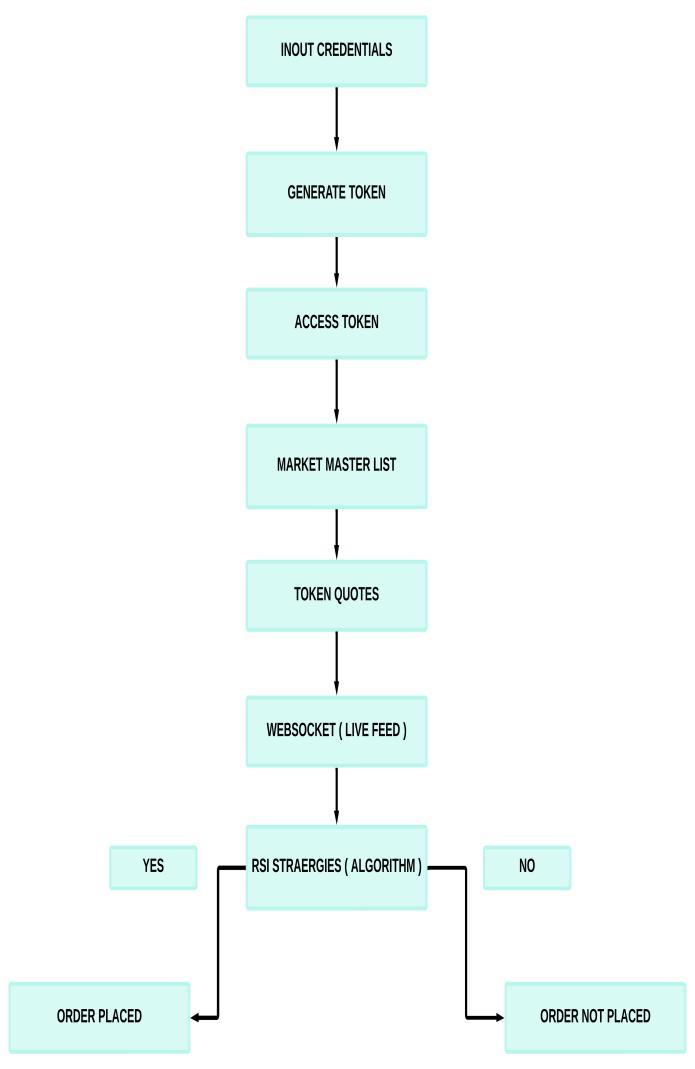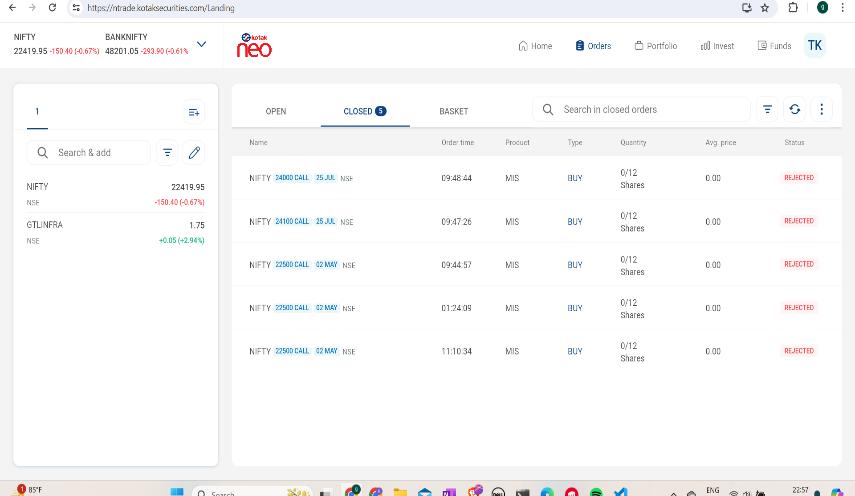
International Research Journal of Engineering and Technology (IRJET) e-ISSN: 2395-0056
Volume: 11 Issue: 10 | Mar 2024 www.irjet.net p-ISSN: 2395-0072


International Research Journal of Engineering and Technology (IRJET) e-ISSN: 2395-0056
Volume: 11 Issue: 10 | Mar 2024 www.irjet.net p-ISSN: 2395-0072
1Gaurangi Raul, 2Riya Jadhav, 3Tejas Kamble, 4Kshitija Satpute
1,2, Dept. of CSE (AI&ML), Smt. Indira Gandhi College of Engineering, Navi Mumbai, Maharashtra, India ***
Abstract - Algorithmic trading, uses pre-programmed instructions to automate trade executions. This research paper investigates the development of an algorithmic trading system using the Kotak API, focusing on the Relative Strength Index (RSI) strategy.
Through APIs, such as WebSocket traders can seamlessly connect their algorithms to brokerage platforms, allowing for real-time data access, order management, and trade execution with high precision and speed.
Key Words: KotakNeoAPI,YahooFinance,RSIalgorithm
The financial markets have witnessed a significant shift towards automation with the rise of algorithmic trading (algo-trading).Thisapproachleveragescomputerprograms toexecutetradesbasedonpre-definedrulesandtechnical indicators,offeringadvantageslikespeed,accuracy,andthe abilitytoremoveemotionsfromtradingdecisions.
This research paper explores the development of an algorithmic trading system specifically designed for the Kotak Securities platform. We will focus on utilizing the RelativeStrengthIndex(RSI)strategy,apopularmomentum oscillator,toidentifypotentialtradingopportunities.
TheRSIanalyzesrecentpricemovementstogaugewhether a stock is overbought or oversold, providing valuable insightsforbuyandselldecisions.ByintegratingtheKotak APIandimplementingtheRSIstrategy,thisresearchaimsto developarobustalgorithmictradingsystem.
ThefollowingsectionswilldelveintothedetailsofKotakAPI integration,RSIindicatorcalculation,thedesignoftheRSIbased trading strategy, back testing and evaluation methodologies, and a paper trading simulation for live markettesting.Throughthiscomprehensiveapproach,we will assess the feasibility and potential benefits of algorithmictradingusingtheKotakAPIandtheRSIstrategy.
AtradingAPI(ApplicationProgrammingInterface)actsasa bridgebetweenyourtradingplatformandyourcustom-built application or software. It allows programmatic access to featureslike:
Market Data: Real-time or historical data on stock prices, volumes,orderbookdepth,andothermarketinformation.
Order Management: Ability to place buy and sell orders, modifyexistingorders,andcancelorderselectronically.
Portfolio Management: Access to your current holdings, accountbalance,andtransactionhistory.
Kotak Mahindra Bank offers APIs relevant to algorithmic trading:
1. Kotak Neo Trade API (offered by Kotak Securities): This API caters specifically to algorithmictradingandprovidesaccesstofeatures like:
Real-time market data: Getliveupdatesonstock prices,volumes,andothermarketinformation.
Order placement and management: Programmaticallyplacebuyandsellorders,modify existingorders,andcancelorders.
Livemarketfeeds: Integratereal-timemarketdata intoyourtradingapplication
YahooFinanceisgenerallyconsideredareliablesource forhistoricalstockdata.YahooFinanceallowsusersto downloadhistoricalprice,dividend,andsplitdatafor moststocksindaily,weekly,ormonthlyformats.This datacanbedownloadedasaCSVfiletobeusedoffline. Insummary,YahooFinancestandsoutasapreferred choiceforcasualinvestorsandtradersseekingquick access to news, quotes, and market data, making it a valuable tool for those looking for a user-friendly interface,advancedresearchcapabilities,andportfolio trackingfeatures
Algorithmictradingbotsandpricepredictionarebeingused a lot in the Indian stock market. These bots use special instructionstomaketradesfasterandmoreaccuratelythan humans.Pricepredictionhelpstradersdecidewhentobuy or sell stocks by using different techniques like looking at pastpatternsorusingcomputerstolearnfromdata.Kotak Securities,acompanyinIndia,hasmadeatoolcalledKotak NeoAPIthathelpstradersusethesebotsandmaketrades easily.Peoplehavedonestudiestoseehowwellthesebots

International Research Journal of Engineering and Technology (IRJET) e-ISSN: 2395-0056
Volume: 11 Issue: 10 | Mar 2024 www.irjet.net
andpricepredictionworkinIndia,andtheyhavefoundthat itcanbesuccessful,butitalsodependsonthespecificbot, the market conditions, and how much risk the trader is willingtotake.
Thereisanincreasingtrendofresearchintotheefficiencyof algorithmic trading and price prediction in the Indian markets. A study titled as Algorithmic Trading in Indian Stock Market examines different algorithmic trading strategies used in India. The study tells the importance of algorithmdesignandmarketconditionsintheperformance of algorithmic trading strategies. Another study tells that algorithmictradingcanindeedbeprofitable.However,there issomeriskassociatedthatoneneedstobeawareof.
Kotak Neo Trade is a powerful APIs that can help you develop your own trading Terminal and implement your strategies easily and intuitively. This APIs give you open accesstolivemarketfeeds,orders,livepositions,andalot more.Ithasauser-friendlyinterfaceanditworkswellwith various platforms therefore, it is convenient for both individualandinstitutionalinvestors
One of the emerging areas in algorithmic trading is called reinforcementlearning.Reinforcementlearningalgorithms learn in doing; interacting with the environment and receiving feedback Early work on algorithmic trading by Harris (2003) and Chan (2009) set the foundational principles,emphasizingtheroleofautomationinimproving theefficiencyoftradeexecutionandminimizingthemarket impact of large orders. These studies highlighted how algorithmic trading systems could optimize execution strategiesbyreducinghumanintervention,particularlyin volatilemarkets.Whilethesestudiesdiscussedthebenefits ofautomatedtrading,theylackedadirectfocusonAPIs,as APIs had not yet become central to the infrastructure of financialmarkets.
TheimportanceofAPIsbecamemoreapparentastrading strategiesgrewmoresophisticatedandmarketconditions moredynamic. Kissell (2014) broughtattentiontotherole ofAPIsinalgorithmictrading,describingthemasthebridge that connects trading algorithms with data sources and brokerage systems. This research underscored how APIs enable automated systems to access real-time data, place orders,andmonitortradeswithoutrequiringhumaninput. KissellfurtherdifferentiatedbetweentypesofAPIs,suchas RESTfulAPIs,whichallowforspecificrequestslikehistorical dataretrieval,andWebSocketAPIs,whichfacilitatereal-time datastreaming.Hisworkwasinstrumentalinshowinghow differentAPIprotocolscouldcatertodifferenttradingneeds, suchashigh-frequencytradingormoretraditionallong-term strategies.
Narayan (2016) delveddeeperintotheapplicationofAPIs inhigh-frequencytrading(HFT),wherespeediscrucialfor success.NarayandemonstratedthatAPIswithlowlatency those that can process data and execute orders within
p-ISSN: 2395-0072
milliseconds are essential for HFT algorithms. He also exploredhowmodernAPIsallowtradersto exploitshortlived arbitrage opportunities, a strategy that requires extremelyfastreactiontimes.Hisstudyprovidedevidence thatAPIssignificantlyenhancetheexecutionofsuchtimesensitive trades, contributing to the growing body of researchthatemphasizestheroleoftechnologyinmodern trading.
In 2019, Li Xucheng and Peng Zhihao proposed a new algorithmic trading model combining artificial intelligent into it. While this study demonstrated the profitability of applying reinforcement learning algorithms towards algorithmictrading,albeitmarginal,netprofit.
Ye and Dejun (2018) developed event-based algorithmic tradingstrategiesinvolvingthestocknews,earningsreports, and sentiment changes, all leading to stock price motion. Accordingtotheauthors,theyputforwardatradingsystem that applies moving average, searches for candlestick patterns in search of reversal points and places orders automatically.Theyhoweverstressedontheimportanceof contingencyplanning,riskmanagementandthecomplexity associated therein while accurately predicting the market reaction.
Recentstudieshavecontinuedtoexplorethecutting-edge applications of APIs in algorithmic trading. Shah (2020) focused on the growing trend of cloud-based APIs, which allow traders to access computational power and data storage remotely, thus reducing the infrastructure costs traditionally associated with algorithmic trading. Shah argued that cloud-based APIs enable greater scalability, allowingtraderstoaccessmultiplemarketssimultaneously and run more complex algorithms without the need for expensiveon-premisehardware. Gupta (2021) tookthisa step further by investigating AI-driven APIs that provide predictive analytics and sentiment analysis, tools that are increasingly being used to enhance algorithmic decisionmaking.
Technical analysis is amongst the oldest and popular techniquesforpriceprediction.Thisinvolvesstudyingthe pastmarketprices,thechartpatternstodetectthetrends andforecastthepricesmovementsinthefuture.
Technical analysts use moving averages, support and resistancelevelsandavarietyofothertechnicalindicators to understand the possible market directions for trading which will help the traders during buying and selling. Whereas technical analysis considers historical data on price,fundamentalanalysisisamorethoroughexamination of the company’s strengths and weaknesses in order to discovertheactualvalue.Itisbasedonconsideringdifferent financialratioslikeearnings,revenue,thedebtlevelsandthe expertise of the management in order to get information aboutthecompany’sprospectsinthefuture.

International Research Journal of Engineering and Technology (IRJET) e-ISSN: 2395-0056
Volume: 11 Issue: 10 | Mar 2024 www.irjet.net p-ISSN: 2395-0072
This strategy utilizes the Relative Strength Index (RSI) to identify potential buy and sell signals within the Kotak algorithmictradingenvironment.
Core Functionality:
RSI Calculation: ThestrategywillcalculatetheRSI value for a chosen security using historical price dataretrievedviatheKotakNeoTradeAPI.Libraries like TA-Lib or pandas-ta can be used for this purpose.
Overbought/Oversold Thresholds: The strategy will define specific RSI thresholds to identify overbought (above a certain value) and oversold (below a certain value) conditions in the security. CommonRSIthresholdsare70foroverboughtand 30foroversold,butthesecanbecustomizedbased onbacktestingandrisktolerance.
Trading Signals:
Buy Signal: If the RSI falls below the oversold threshold, the strategy will generate a buy signal, indicatingapotentialbuyingopportunity.
Sell Signal: Conversely, if the RSI rises above the overboughtthreshold,thestrategywillgeneratea sellsignal,promptingthesaleofthesecurity.
Additional Considerations:
Stop-LossOrders: Thestrategyshouldincorporate stop-lossorderstolimitpotentiallossesiftheprice moves against the anticipated direction. Stop-loss orderscanbeplacedautomaticallyusingtheKotak NeoTradeAPI.
Exit Strategy: While RSI provides entry and exit signals based on overbought/oversold conditions, additional technical indicators or price action confirmation might be implemented for a more robustexitstrategy.
Back testing and Optimization: The strategy's effectiveness should be rigorously evaluated throughback testingonhistorical data. Thishelps refine the RSI thresholds, identify potential weaknesses, and optimize the strategy for the chosenmarketandtimeframe.

Fig.1.RSIindex
Benefits:
AutomatedTrading: Thestrategyautomatestrade execution based on pre-defined RSI signals, removing emotions from the decision-making process.
Trend Identification: RSI can help identify potential trends by analyzing the speed and magnitudeofpricemovements.
Risk Management: Stop-loss orders can be integratedtolimitpotentiallosses.
Development Environment Setup:
Programming Language: Chooseasuitableprogramming language like Python for its extensive libraries and communitysupportforalgorithmictrading.
Libraries: Installnecessarylibrariesfordatamanipulation (pandas), technical analysis (TA-Lib or pandas-ta), API integration(requests),andpotentiallycharting(Matplotlib).
Kotak Neo Trade API Integration: ObtainAPIcredentials fromtheKotakDeveloperConnectportalandintegratethe APIwithinyourcodeusingtheprovidedlibraries.
Data Acquisition:
Security Selection: Define the security (stock, ETF) you wanttotradeandensureit'ssupported bythe Kotak Neo TradeAPI.
Historical Data Retrieval: UtilizetheKotakNeoTradeAPI toretrievehistoricalpricedataforthechosensecurity.This datawillbeusedforRSIcalculationandbacktesting.

International Research Journal of Engineering and Technology (IRJET) e-ISSN: 2395-0056
Volume: 11 Issue: 10 | Mar 2024 www.irjet.net p-ISSN: 2395-0072
RSI Calculation:
Formula Implementation: Implement the RSI formula within your code using libraries like TA-Lib or pandas-ta. Theformulaconsiderstheaverageofrecentgainsandlosses togaugethemomentumandidentifyoverbought/oversold conditions.
RSI Threshold Definition: Set specific RSI thresholds to define overbought (typically above 70) and oversold (typicallybelow30)zones.Thesethresholdscanbeadjusted basedonbacktestingresultsandrisktolerance.
Trading Strategy Design:
Signal Generation: BasedonthecalculatedRSIvaluesand defined thresholds, develop code to generate buy and sell signals.
Order Management: Integrate order placement functionalities with the Kotak Neo Trade API to automatically execute buy and sell orders based on generatedsignals.
Stop-LossIntegration: Implementstop-lossorderstolimit potential losses if the price moves against the anticipated direction.Stop-lossorderscanbeplacedautomaticallyusing theKotakAPI.
HistoricalDataSimulation: Utilizetheretrievedhistorical price data to simulate the trading strategy's performance over a specific period. This helps assess profitability, win rate,andriskmetrics.
Performance Analysis: Analyzethebacktestingresultsto evaluate the strategy's effectiveness. Identify potential weaknesses and optimize parameters like RSI thresholds basedonthefindings.
Paper Trading Simulation (Optional):
Simulated Environment: Oncethestrategyisbacktested and refined, consider a paper trading simulation. This involves running the strategy with virtual funds in a simulated market environment offered by some brokers. This provides a real-world testing ground without risking actualcapital.
Performance Monitoring: Continuously monitor the strategy's performance during paper trading and make furtheradjustmentsifnecessary.
Real Market Execution: After thorough testing and refinement,thestrategycanbedeployedwithrealcapital.
However, proceed with caution and start with a small amounttoassesslivemarketperformance.
Risk Management: Alwaysprioritizeriskmanagementby setting appropriate stop-loss orders and position sizing strategies.
Market Conditions: Algorithmictradingstrategiesrequire ongoing monitoring and adaptation as market conditions evolve.
Performance Tracking: Regularly track the strategy's performance and make adjustments as needed based on real-timedataandmarketchanges.

Fig.2Algorithmworkflow
Data Acquisition and token generation:
Integrating with exchange and market data APIs to fetch real-time market information. Data acquisition in an algorithmictradingbotinvolvesgatheringreal-timemarket datafromvarioussourcessuchascryptocurrencyexchanges and market data aggregators. This data includes price, volume, and other relevant market information necessary for the bot to analyze and identify potential trading opportunitiesAdditionally,thedataacquisitionprocessmay involve historical market data analysis to evaluate the performance of trading strategies before live execution in themarkets.
Thesetokensserveasauthenticationcredentialsthatallow thebottosecurelyconnecttotheexchangeAPIsandexecute

International Research Journal of Engineering and Technology (IRJET) e-ISSN: 2395-0056
Volume: 11 Issue: 10 | Mar 2024 www.irjet.net p-ISSN: 2395-0072
trades on behalf of the trader. By generating and utilizing these tokens, the trading bot gains the necessary permissionstoaccessreal-timemarketdata,placebuyand sell orders, and implement trading strategies effectively withintheexchangeenvironment
Fetch historical data:
To fetch historical data from Yahoo Finance, you can use Pythonlibrarieslikeyfinancetoaccessfinancialinformation andhistoricalmarketdata.ByutilizingtheTickerfunction from yfinance, you can retrieve various data sets such as financialratios,historicalprices,andkeymetricsforspecific companies listed on Yahoo Finance. Additionally, you can specifytheperiodoftimeforwhichyouwanthistoricaldata, whetherit'sforaspecificdaterangeorapredefinedperiod like1d,5d,1mo,6mo,1y,andmore.

TheRSIisatechnicalanalysisindicatorthatmeasuresthe momentum of a price movement. It is often used in combination with other indicators, such as the Stochastic Oscillator,togeneratebuyandsellsignals.Backtestingand optimization are crucial steps in developing an RSI-based trading bot. The bot's performance should be evaluated usinghistoricalmarketdatatoensurethetradingstrategyis profitablebeforedeployingitinlivetrading.Insummary,the RSI strategy can be effectively implemented in an algorithmictradingbottoautomatethetradingprocessand potentiallycapitalizeonmarketopportunities.
A successful algorithmic trading bot relies on adaptive strategiesthatcandetectpatternsinvastamountsofdata. These strategies govern the bot's buying and selling decisions. In summary, monitoring and analyzing orders placed by an algorithmic trading bot involve real-time visualization, surveillance for compliance and risk management,constantmonitoringofmarketactivities,and theimplementationofadaptivetradingstrategies.



International Research Journal of Engineering and Technology (IRJET) e-ISSN: 2395-0056
Volume: 11 Issue: 10 | Mar 2024 www.irjet.net p-ISSN: 2395-0072
Thisresearchexploredthedevelopmentofanalgorithmic trading system utilizing the Kotak Neo Trade API and the RelativeStrengthIndex(RSI)strategy.Theprojectfocused onintegratingtheAPIforreal-timemarketdataaccessand orderexecution.WediscussedtheRSIindicatorcalculation and its use in generating buy and sell signals based on overbought/oversoldconditions.Themethodologyoutlined backtestingforstrategyoptimizationandriskmanagement through stop-loss orders. While WebSocket’s were mentionedasapotentialfuturetechnologyforreal-timedata communication,theinitialfocusremainedonthecoreRSI strategy and the Kotak API functionalities. Overall, this project provided a framework for building an algorithmic tradingsystemusingtheKotakNeoTradeAPIandtheRSI strategy, emphasizing the importance of back testing, optimization, and risk management practices before deployingrealcapital.
I. Machine Learning and Artificial Intelligence (AI): Integrating machine learning algorithms into trading strategies can lead to more sophisticated pattern recognition, risk assessment, and potentiallysuperiorperformance.AIcouldanalyze vast datasets and identify complex market relationshipsthattraditionalindicatorsmightmiss.
II. High-Frequency Trading (HFT): HFT strategies leverage advanced algorithms and hardware to executetradesatultra-fastspeeds,capitalizingon fleeting market inefficiencies. As technology continues to evolve, HFT is expected to become even more prevalent, demanding ever-faster and moreefficientalgorithmictradingsystems.
III. Regulation and Transparency: As algorithmic tradinggrows,regulatoryframeworkswillneedto adapttoensurefairness,transparency,andmarket stability. Algorithmic transparency and potential biaseswithinthesesystemswillbecrucialareasof discussion.
IV. Democratization of Algorithmic Trading: Traditionally,algorithmictradingwasthedomainof hedgefundsandlargeinstitutions.Advancementsin technology and user-friendly platforms could democratize algorithmic trading, allowing individual investors to participate with their own strategies.
Algorithmic Trading:
"Advances in Financial Machine Learning" by MarcosLopezdePrado(Book)
"Quantitative Trading: Building Your Own Algorithmic Trading Business" by Ernest Chan (Book)
https://www.investopedia.com/articles/trading/1 1/automated-trading-systems.asp
Kotak Neo Trade API:
While official public documentation might be limited, try exploring resources within the Kotak Developer Connect portal after registering: https://www.kotak.com/en/open-banking.html
REST API Integration with Python:
"PythonforAlgorithmicTrading"byYvesHilpisch (Book)
https://realpython.com/lessons/rest-apis-ninja/ Technical Analysis Indicators:
"Technical Analysis of the Financial Markets" by JohnMurphy(Book)
https://www.investopedia.com/terms/r/rsi.asp
Backtesting Algorithmic Trading Strategies:
"BacktestingStrategiesforAlgorithmicTrading"by YvesHilpisch(Book)
https://www.youtube.com/watch?v=EO6mp3bJWh s